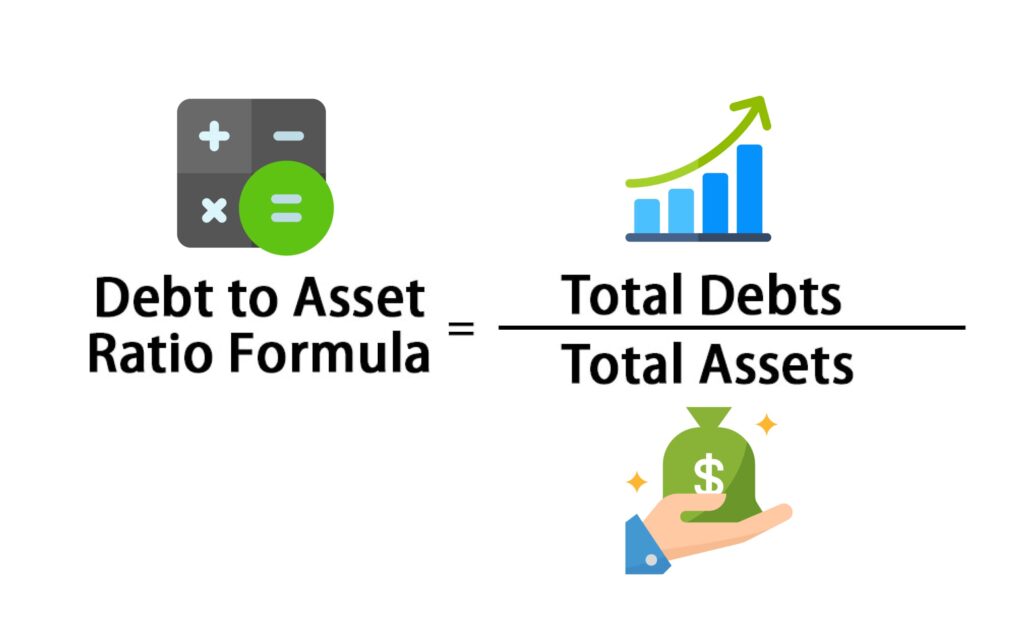
Overview: Debt To Asset Ratio
When determining your probability of default on payments such as credit facilities, the debt to asset ratio can assist you in determining your company’s financial performance. You can also use the indebtedness to capital employed to time provided ratios and the corporation’s economic development over time. When determining the debt to asset ratio and evaluating information, it’s critical to have a thorough understanding of all the accounting transactions you’ll need.
What Is The Debt To Asset Ratio?
The debt to asset ratio also referred to as the ratio of the total loan, measures a company’s financial performance. The deficit proportion of a corporation shows how much of its capital is contributed by obligations (borrowings) rather than ownership. This proportion can be used to track a firm’s improvement over time as it acquires properties.
The debt-to-asset proportion can be used by shareholders to determine if a company seems to have enough income to finance its financial commitments and whether it can expect to be paid rates of return.
A massive debt ratio may indicate that your business will have difficulty obtaining more funds, or that it would be only creditworthy at a higher amount than if the ratio was smaller. Due to the type of multinational enterprise, overleveraged firms may be suffering the consequences of financial distress. Some businesses can afford to borrow more money than others.
How To Calculate The Debt To Asset Ratio?

You will need accessibility to the financial statements of the corporate entity in order to quantify the debt to asset ratio.
The formula:
Debt to Asset = Total Debts/Total Assets = _%
Below are the following steps to calculate the debt to asset ratio:
- Examine the statement of financial position, particularly the debt section of the financial statements, to compute the proportion of the loans. Add the outstanding debts and protracted liabilities altogether.
- Take a glance at the balancing layer’s financial assets. Add the cash reserves and total capital equipment combined.
- Take the number of obligations or liabilities from phase one by the net capital from phase 2. You’ll be given a %.
- You may compute your liabilities proportion now that you’ve entered your numbers into the correct areas in the algorithm. Your outcome should be a fraction if you multiply the outstanding debt by the entire resources. This can also be expressed as a percentage, indicating the proportion of obligations supported by lenders, shareholders, or other financial institutions.
Example:
| Assets | 2020 | Liabilities & Equity | 2020 |
|---|---|---|---|
| Cash | $ 10 | Accounts to be paid | $ 160 |
| Market Securities | 0 | Notes to be paid | 100 |
| Accounts Receivable | 175 | Gross Current Liabilities | 260 |
| Inventory | 615 | Long terms bonds | 554 |
| Gross Current assets | 1000 | Complete liabilities | 814 |
| Net Plant & Equipment | 1000 | Shareholder Equity | 1186 |
| Complete assets | 2000 | Complete liabilities & Equity | 2000 |
Importance Of Debt To Asset Ratio For Businesses
- Businesses with greater debt to asset ratios could be vulnerable, particularly if interest rates go up.
- Lenders like minimal debt proportions because the less the proportion, the more financial leverage there is, which protects bondholders from damages if the company goes out of business.
- Lenders are concerned when a firm has a big amount of debt. They may even bring in some of the outstanding debt to them by the corporation.
- These judgments are not always shared by the company’s shareholders.
- If the investment is in the future via borrowed funds, the company’s stockholders maintain ownership without having to increase their stake.
- When a company is worth more on capital invested with cheap credit than it spends on loans, the rewards to shareholders are enhanced. The investment’s liabilities, on the other hand, are amplified.
Comparative Ratio Analysis
Comparing the proportion outcome to prior years of the variable for your company utilizing trends or moment tool to determine special significance. Trends analysis involves the study of reviewing data from an income statement over the period to see if the liabilities proportion is growing, declining, or keeping the very same. The moving average can provide a lot of information about a financial indicator to the ownership or administrative management. The business process is the main type of comparable research methodology you should do. You examine the debt-to-asset proportion of other organizations in the industry to undertake market research. You try to figure out why your debt to asset ratio isn’t the same.
Read More: Allotment Of Shares
Advantages & Drawbacks Of Debt To Asset Ratio
Advantages:
- Since debt has a more positive impact on profitability than an asset, raising the debt-to-equity proportion to a certain threshold might significantly decrease a company’s risk premium.
- A massive debt ratio indicates that a company’s working capital may be used to meet debt commitments while also allowing it to be used to boost investment performance and sustainable growth.
- Increased loan usage boosts the firm’s earnings per share. When debt is employed rather than ownership, therefore, the investment quantity is reduced and the profit earnings are larger.
Drawbacks:
- It is the responsibility of the company owner or financial management to ensure that they are matching apples with oranges.
- To put it another way, if they’re evaluating their debt-to-asset proportions to those of other companies in the same industry, they have to make sure that the denominator of the calculation is one and the same.
- Additional problem is that business organizations in the same sector employ various financial statements.
- Any comparability will be invalid if some organizations use one merchandise accrual accounting or one amortization technique while others use different methodologies.
- To acquire an appropriate debt-to-asset proportion assessment, banking and economic executives must utilize sound judgment and look beyond the figures.
Conclusion
So, this is all about how to calculate the debt to asset ratio. If you wish to know about it for any specific country. Contact Odint Consulting, we will guide you through each step of the procedures.
FAQ’s
Borrowing ratios are used to evaluate how much credit an organization employs to finance its activities. They could also be used to evaluate a cash flow budget and its associated debts. Support organizations about these metrics because their stock interests in a company could be jeopardized if the borrowing level is very high.
However, most individuals believe a proportion of 40% or less to be optimum. However, they frequently regard a high proportion of 60% or more as unsatisfactory. As your debt-to-asset proportion approaches 60%, you may find it difficult to satisfy your responsibilities.
